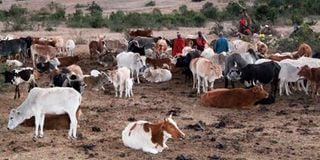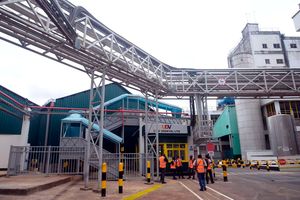Premium
Climate, land issues driving Laikipia strife

Herders graze their cattle at Ole Naishu Conservancy in Laikipia North in August following an agreement.
May 13 was like any other day at the Laikipia Nature Conservancy. Suddenly, its director, Kuki Gallman, made a distress call; she had been shot by cattle raiders while driving along the southern boundary of the property.
She sustained gunshot wounds below the knee in the incident that immediately seemed to have occurred because she surprised the armed raiders numbering at least 40 as they crossed the conservancy.
Two hours later, the raiders stole 265 cattle from a neighbouring Samburu community before driving the cattle into Baringo County.
It was not the first time that the Italian-born Kenyan author, environmental activist and conservationist was being shot inside her own land, a 365-square-kilometer conservancy that provides an important sanctuary for wildlife and is used as a breeding ground for elephants.
Through the years, the conservancy, also known as the Ol Ari Nyiro (the place of dark springs) has borne the brunt of it all. In recent years, the ranch and others neighbouring it have been the epicentre of a violent struggle involving climate change, herders and politics of land and power.
Although the violence in the conservancy manifests itself as cattle raiding or fights between communities drawn from West Pokot, Laikipia, Samburu and Kisii counties, authorities and security analysts suspect that it is politically motivated.
It is for this reason that Tiaty MP William Kamket and former Laikipia North MP Mathew Lempurkel were arrested.
At Ol Moran centre in Laikipia where the violence there for close to a week has led to the deaths of at least 12 people, residents believe that members of the Samburu and Pokot communities were using cattle theft, school raids and attacks on other communities as a smokescreen.
“They have for a very long time wanted to evict the conservationists who own thousands of acres of land in the Laikipia Plateau. The conservancies are the most important water catchment area for two major lakes; Bogoria and Baringo.
“During drought, herders want to drive their cattle into this huge land that has no residential houses, but are barred by authorities. Their politicians have been making statements that the communities deserve this land and giving them hope that they will one day reclaim it, and this motivates them to fight and make the settlers uncomfortable” resident and peace ambassador Peter Ole Lemiso said.
At least 36 conservancies own huge chunks of land in Laikipia, with most engaged in the tourism business. They include Ol Ari Nyiro (close to 100,000 acres) and Ol-Pejeta with 90,000 acres.
After her attack in May, Ms Gallmann blamed the perennial conflicts to land degradation and competition for water and pasture.
“The need for water and pasture is rising inexorably as cattle numbers rise and climate change depletes the natural resources. Together with low engagement in education and a surge in gun ownership, these strains are leading to escalating violence and rising destabilisation,” she said.
The proximity of the conservancy to the troubled North-Eastern region has exposed it to armed conflict, with authorities suspecting that locals were accessing guns from neighbouring countries. At the moment, the Kenya Defence Forces and several police formations and units are deployed in the area to quell violence.





